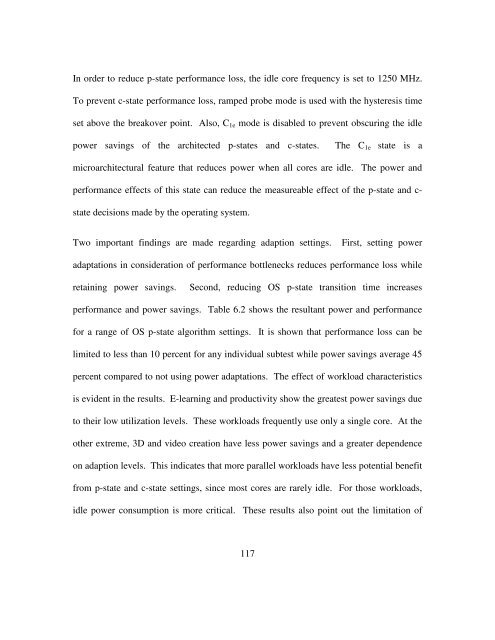Copyright by William Lloyd Bircher 2010 - The Laboratory for ...
Copyright by William Lloyd Bircher 2010 - The Laboratory for ...
Copyright by William Lloyd Bircher 2010 - The Laboratory for ...
Create successful ePaper yourself
Turn your PDF publications into a flip-book with our unique Google optimized e-Paper software.
In order to reduce p-state per<strong>for</strong>mance loss, the idle core frequency is set to 1250 MHz.<br />
To prevent c-state per<strong>for</strong>mance loss, ramped probe mode is used with the hysteresis time<br />
set above the breakover point. Also, C1e mode is disabled to prevent obscuring the idle<br />
power savings of the architected p-states and c-states. <strong>The</strong> C1e state is a<br />
microarchitectural feature that reduces power when all cores are idle. <strong>The</strong> power and<br />
per<strong>for</strong>mance effects of this state can reduce the measureable effect of the p-state and c-<br />
state decisions made <strong>by</strong> the operating system.<br />
Two important findings are made regarding adaption settings. First, setting power<br />
adaptations in consideration of per<strong>for</strong>mance bottlenecks reduces per<strong>for</strong>mance loss while<br />
retaining power savings. Second, reducing OS p-state transition time increases<br />
per<strong>for</strong>mance and power savings. Table 6.2 shows the resultant power and per<strong>for</strong>mance<br />
<strong>for</strong> a range of OS p-state algorithm settings. It is shown that per<strong>for</strong>mance loss can be<br />
limited to less than 10 percent <strong>for</strong> any individual subtest while power savings average 45<br />
percent compared to not using power adaptations. <strong>The</strong> effect of workload characteristics<br />
is evident in the results. E-learning and productivity show the greatest power savings due<br />
to their low utilization levels. <strong>The</strong>se workloads frequently use only a single core. At the<br />
other extreme, 3D and video creation have less power savings and a greater dependence<br />
on adaption levels. This indicates that more parallel workloads have less potential benefit<br />
from p-state and c-state settings, since most cores are rarely idle. For those workloads,<br />
idle power consumption is more critical. <strong>The</strong>se results also point out the limitation of<br />
117




